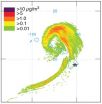(Press-News.org) DURHAM, N.C. -- Some people can handle stressful situations better than others, and it's not all in their genes: Even identical twins show differences in how they respond.
Researchers have identified a specific electrical pattern in the brains of genetically identical mice that predicts how well individual animals will fare in stressful situations.
The findings, published July 29 in Nature Communications, may eventually help researchers prevent potential consequences of chronic stress -- such as post-traumatic stress disorder, depression and other psychiatric disorders -- in people who are prone to these problems.
"In soldiers, we have this dramatic, major stress exposure, and in some individuals it's leading to major issues, such as problems sleeping or being around other people," said senior author Kafui Dzirasa, M.D., Ph.D., an assistant professor of psychiatry and behavioral sciences at Duke University Medical Center and a member of the Duke Institute for Brain Sciences. "If we can find that common trigger or common pathway and tune it, we may be able to prevent the emergence of a range of mental illnesses down the line."
In the new study, Dzirasa's team analyzed the interaction between two interconnected brain areas that control fear and stress responses in both mice and men: the prefrontal cortex and the amygdala. The amygdala plays a role in the 'fight-or-flight' response. The prefrontal cortex is involved in planning and other higher-level functions. It suppresses the amygdala's reactivity to danger and helps people continue to function in stressful situations.
Implanting electrodes into the brains of the mice allowed the researchers to listen in on the tempo at which the prefrontal cortex and the amygdala were firing and how tightly the two areas were linked -- with the ultimate goal of figuring whether the electrical pattern of cross talk could help decide how well animals would respond when faced with an acute stressor.
Indeed, in mice that had been subjected to a chronically stressful situation -- daily exposure to an aggressive male mouse for about two weeks -- the degree to which the prefrontal cortex seemed to control amygdala activity was related to how well the animals coped with the stress, the group found.
Next the group looked at how the brain reacted to the first instance of stress, before the mice were put in a chronically stressful situation. The mice more sensitive to chronic stress showed greater activation of their prefrontal cortex-amygdala circuit, compared with resilient mice.
"We were really both surprised and excited to find that this signature was present in the animals before they were chronically stressed," Dzirasa said. "You can find this signature the very first time they were ever exposed to this aggressive dangerous experience."
Dzirasa hopes to use the signatures to come up with potential treatments for stress. "If we pair the signatures and treatments together, can we prevent symptoms from emerging, even when an animal is stressed? That's the first question," he said.
The group also hopes to delve further into the brain, to see whether the circuit-level patterns can interact with genetic variations that confer risk for psychiatric disorders such as schizophrenia. The new study will enable Dzirasa and other basic researchers to segregate stress-susceptible and resilient animals before they are subjected to stress and look at their molecular, cellular and systemic differences.
INFORMATION:
This work was supported by the National Institute of Mental Health (R37MH073853, R01MH099192), International Mental Health Research Organization RSA, BBRF Sidney R. Baer Jr. Research Prize, and the Duke Institute for Brain Sciences.
CITATION: "Prefrontal cortex reactivity underlies trait vulnerability to chronic social defeat stress," Sunil Kumar, Rainbo Hultman, Dalton Hughes, Nadine Michel, Brittany M. Katz, Kafui Dzirasa. Nature Communications, July 29, 2014. DOI: 10.1038/ncomms5537
A new brain-based marker of stress susceptibility
Finding might help prevent mental illnesses linked with stress
2014-07-29
ELSE PRESS RELEASES FROM THIS DATE:
First grade reading suffers in segregated schools
2014-07-29
A groundbreaking study from the Frank Porter Graham Child Development Institute (FPG) has found that African-American students in first grade experience smaller gains in reading when they attend segregated schools—but the students' backgrounds likely are not the cause of the differences.
According to the Center for Civil Rights, although the United States is becoming more racially and ethnically diverse, segregation is still on the rise. To better understand segregation's impact on student performance, FPG scientists looked at nearly 4000 first graders in public schools ...
Local education politics 'far from dead'
2014-07-29
EAST LANSING, Mich. --- Teach for America, known for recruiting teachers, is also setting its sights on capturing school board seats across the nation. Surprisingly, however, political candidates from the program aren't just pushing its national education agenda, they're advancing local issues as well, according to a new study.
The findings, said Michigan State University's Rebecca Jacobsen, refute the argument that school boards have become ineffective and obsolete in the wake of national education reform. Teach for America, a nonprofit that enlists high-achieving college ...
Wildfires continue near Yellowknife, Canada
2014-07-29
The wildfires that have been plaguing the Northern Territories in Canada and have sent smoke drifting down to the Great Lakes in the U.S. continue on. NASA's Aqua satellite collected this natural-color image with the Moderate Resolution Imaging Spectroradiometer, MODIS, instrument on July 26, 2014. Actively burning areas, detected by MODIS's thermal bands, are outlined in red. Copious amount of smoke are drifting northward in this image. Smoke is also creating havoc for residents of Yellowknife. Fire has caused power outages in the area and because of the smoke, line ...
Stem cell advance may increase efficiency of tissue regeneration
2014-07-29
A new stem-cell discovery might one day lead to a more streamlined process for obtaining stem cells, which in turn could be used in the development of replacement tissue for failing body parts, according to UC San Francisco scientists who reported the findings in the current edition of Cell.
The work builds on a strategy that involves reprogramming adult cells back to an embryonic state in which they again have the potential to become any type of cell.
The efficiency of this process may soon increase thanks to the scientists' identification of biochemical pathways ...
New research reveals Pele is powerful, even in the sky
2014-07-29
One might assume that a tropical storm moving through volcanic smog (vog) would sweep up the tainted air and march on, unchanged. However, a recent study from atmospheric scientists at the University of Hawai'i – Mānoa (UHM) revealed that, though microscopic, gasses and particles from Kilauea volcano exerted an influence on Tropical Storm Flossie – affecting the formation of thunderstorms and lightning in the sizeable storm.
In July 2013, as Flossie approached the Hawaiian Islands, satellites steadily monitored lightning, rainfall, cloud cover, temperature and ...
Herpes remains active even when no symptoms appear
2014-07-29
Scientists investigating the herpes virus have been surprised to find an ongoing conflict in the cells of sufferers, even when the virus is apparently dormant.
Herpes Simplex Type 1 is a virus that causes cold sores. It remains in the body's nervous system indefinitely after infection. Around 80 per cent of Australians carry the virus, although it is usually in a dormant state.
"We thought when the disease was dormant, it was a truce," said Associate Professor David Tscharke from The Australian National University Research School of Biology. "It turns out that the virus ...
How does microRNA-124 promote the neuronal differentiation of BMSCs?
2014-07-29
MicroRNAs (miRNAs) play an important regulatory role in the self-renewal and differentiation of stem cells. Dr. Defeng Zou and co-workers from the First Affiliated Hospital of China Medical University, China focuses on the effect of miRNA overexpression on the differentiation of bone marrow-derived mesenchymal stem cells into neurons. In the study released on the Neural Regeneration Research (Vol. 9, No. 12, 2014), researchers used GeneChip technology to analyze the expression of miRNAs in bone marrow-derived mesenchymal stem cells, neural stem cells and neurons. They constructed ...
Prolonged electrical stimulation causes no damage to sacral nerve roots in rabbits
2014-07-29
Previous studies have shown that, anode block electrical stimulation of the sacral nerve root can produce physiological urination and reconstruct urinary bladder function in rabbits. However, whether long-term anode block electrical stimulation causes damage to the sacral nerve root remains unclear, and needs further investigation. In a recent study reported on the Neural Regeneration Research (Vol. 9, No. 12, 2014), Dr. Peng Yan and co-workers from Jilin University, China established a complete spinal cord injury model in New Zealand white rabbits through T9-10 segment ...
Evolution in rainforest flies points to climate change survival
2014-07-29
Scientists believe some tropical species may be able to evolve and adapt to the effects of climate change.
The new findings published in the journal, Proceedings of the Royal Society B, suggests some sensitive rainforest-restricted species may survive climate change and avoid extinction. But only if the change is not too abrupt and dramatically beyond the conditions that a species currently experiences.
Previous research offered a bleak prospect for tropical species' adaptation to climate change, now researchers from Monash University believe the situation may not be ...
Vaccine website could increase uptake
2014-07-29
Giving parents access to a dedicated website on the measles, mumps and rubella (MMR) vaccine is the most cost-effective way to increase uptake, say experts.
The study published in the British Journal of General Practice, recommends that a dedicated website be developed as part of guidelines on the MMR vaccine.
Led by Dr Swati Shourie from Monash University and Dr Sandy Tubeuf from the University of Leeds in the UK, the research is the first to look at the economics of providing information about the MMR vaccine. As well as reducing parents' concern about immunising ...
LAST 30 PRESS RELEASES:
University of Phoenix College of Doctoral Studies releases white paper on AI-driven skilling to reduce burnout and restore worker autonomy
AIs fail at the game of visual “telephone”
The levers for a sustainable food system
Potential changes in US homelessness by ending federal support for housing first programs
Vulnerability of large language models to prompt injection when providing medical advice
Researchers develop new system for high-energy-density, long-life, multi-electron transfer bromine-based flow batteries
Ending federal support for housing first programs could increase U.S. homelessness by 5% in one year, new JAMA study finds
New research uncovers molecular ‘safety switch’ shielding cancers from immune attack
Bacteria resisting viral infection can still sink carbon to ocean floor
Younger biological age may increase depression risk in older women during COVID-19
Bharat Innovates 2026 National Basecamp Showcases India’s Most Promising Deep-Tech Ventures
Here’s what determines whether your income level rises or falls
SCIE indexation achievement: Celebrate with Space: Science & Technology
Children’s Hospital Colorado performs region’s first pediatric heart and liver dual organ transplant
Australian team discover why quantum computers have memory problems over time
What determines the fate of a T cell?
Candida auris: genetic process revealed which could be treatment target for deadly fungal disease
Groundbreaking discovery turns household plastic recycling into anti-cancer medication
Blocking a key inflammatory pathway improves liver structure and vascular function in cirrhosis, study finds
Continuous spread: Raccoon roundworm detected in nine European countries
HKUST Engineering researchers developed a novel photodetector to enhance the performance of on-chip light monitoring
Strategic river sensors could have forewarned of Texas Camp flood disaster
Drone sampling of whale breath reveals first evidence of potentially deadly virus in Arctic
Roman soldiers defending Hadrian’s Wall infected by parasites, study finds
Pinochet’s prisoners were tormented with music but still found solace in it, a new book reveals
Fertility remains high in rural Tanzania despite access to family planning
AI-assisted device can improve autism care access
Kinetic careers
Uncovering how parasitic plants avoid attacking themselves to improve crop resistance
Nanoparticle vaccine strategy could protect against Ebola and other deadly filoviruses
[Press-News.org] A new brain-based marker of stress susceptibilityFinding might help prevent mental illnesses linked with stress




